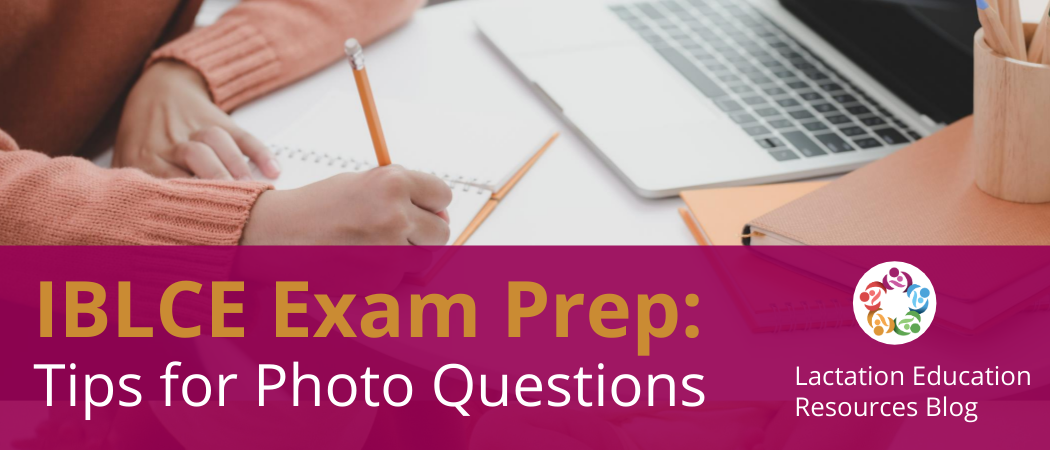

If you are prepping for the IBCLC exam, you probably already know the exam is a very visual experience. Photos are everywhere – and nearly every question on the exam’s second half is associated with an image of some kind.
Honing your image-interpretation skills is one key to passing the exam.
We asked Angela Love-Zaranka, LER Program Director, for her top tips on practicing for questions containing images.
Ask yourself what you’re not seeing.
In the course of your training, what ages and stages of nurslings are you seeing, and in what contexts? Those are likely becoming familiar to you. The ones you aren’t seeing are the ones you need to seek out.
In the course of your training, what ages and stages of nurslings are you seeing, and in what contexts? Those are likely becoming familiar to you. The ones you aren’t seeing are the ones you need to seek out.
If you are training in a community-based setting, for example, search out hospital-based images, like a baby in the NICU. If you are hospital-based, you are more likely to be familiar with the early stages of the nursing relationship and could benefit from images of older nurslings. Not familiar with two year olds that breastfeed? A toddler latch does not look the same as a newborn latch!
Get creative with finding practice images.
Not sure where to look for images?
Not sure where to look for images?
The Breastfeeding Atlas is a great place to start, and will be a great reference for your practice. Find it at a discount at the LER Bookstore.
Being on social media can also be very helpful, looking at pictures people are willing to share. Engage in the conversations people are having about those images, and practice your clinical thinking skills.
Of course, there are also practice images in the LER exam prep course! Our cutting-edge practice exam tool, QBank, contains 570 instant-feedback questions, and a large percentage of those have photos.
Seek Out Diverse Images
Both for the exam and your future practice, it is extremely important to familiarize yourself with images featuring diverse skin tones. Lactation-related conditions can present very differently depending on the skin tone of the individual, and if you have not seen diverse images in your training, you may miss something – on the exam or with a client.
Both for the exam and your future practice, it is extremely important to familiarize yourself with images featuring diverse skin tones. Lactation-related conditions can present very differently depending on the skin tone of the individual, and if you have not seen diverse images in your training, you may miss something – on the exam or with a client.
One great resource: The Melanated Mammary Atlas. This subscription-based online atlas offers images displaying mammary related conditions on Asian, Indigenous, Black, and Brown skin.
Spend extra time on “ages and stages” images
Many people struggle with the “ages and stages,” which require the test taker to identify a baby’s age based on a photo. It’s helpful to look at pictures of babies in general – scroll through Instagram feeds, flip through old photo albums. Look at pictures of babies, see what they are doing, and see how closely you can estimate the baby’s age. For example, if a baby is holding a cup, ask yourself: At what age do babies usually hold a cup? At what age would you see crawling, cruising, or walking?
Many people struggle with the “ages and stages,” which require the test taker to identify a baby’s age based on a photo. It’s helpful to look at pictures of babies in general – scroll through Instagram feeds, flip through old photo albums. Look at pictures of babies, see what they are doing, and see how closely you can estimate the baby’s age. For example, if a baby is holding a cup, ask yourself: At what age do babies usually hold a cup? At what age would you see crawling, cruising, or walking?
The CDC also offers a great resource for learning your ages and stages. Alongside developmental checklists so you can learn the developmental milestones at each age, this site offers a free library of photos and videos. Study suggestion: Download the illustrated milestone checklists, cut the identifying info off the top, and test yourself to see if you can match ages to the correct checklists.
The more you practice this one, the more confident you’ll get.
Be prepared for less-than-optimal photo quality.
Some of the images you will encounter on the exam will be grainy or have poor lighting. Don’t let this throw you off! Why the less-than-studio quality photos? Because it isn’t possible to plan a photoshoot for an image like “mastitis in a person with a dark complexion.” Instead, the exam relies on the lactation community to provide clinical photos, and we’re not professional photographers working in perfect conditions! That being said, the examiners have determined that a lactation consultant should be able to answer the question based on the image and the rest of the question.
Some of the images you will encounter on the exam will be grainy or have poor lighting. Don’t let this throw you off! Why the less-than-studio quality photos? Because it isn’t possible to plan a photoshoot for an image like “mastitis in a person with a dark complexion.” Instead, the exam relies on the lactation community to provide clinical photos, and we’re not professional photographers working in perfect conditions! That being said, the examiners have determined that a lactation consultant should be able to answer the question based on the image and the rest of the question.
You’ve got this!
Remember to think like a lactation consultant. If you hold other credentials or training, be sure to set that aside when answering exam questions. Focus on the training you received in clinical skills. Think back to the patients you’ve already worked with, and bring your best assessment of the situation. You are ready to step into this role – and we’re here to support you!
Remember to think like a lactation consultant. If you hold other credentials or training, be sure to set that aside when answering exam questions. Focus on the training you received in clinical skills. Think back to the patients you’ve already worked with, and bring your best assessment of the situation. You are ready to step into this role – and we’re here to support you!
Feel Prepared to soar through your IBLCE Exam. LER offers two exam prep courses designed to help you study efficiently and effectively.
Enroll Now
Enroll Now